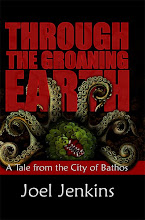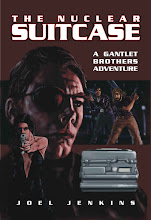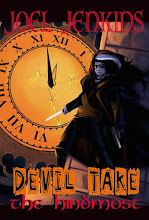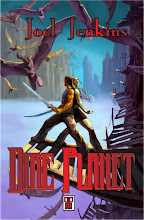Wednesday, November 27, 2013
World Building In Action Fiction
The rule for world building in Action Fiction is simple: Never use a paragraph when a sentence will suffice.
Successfully executing this maxim, however, takes restraint and the development of certain skills. The idea is to avoid infodumps--long passages that explain the world in which the character resides and which slow down the progression of the story line. Many readers find these passages deadly boring and may discard your story in favor of something that requires less attention span--like TV or a video game. Even a couple paragraphs of exposition can be too much.
The trick is divulging bits about your carefully crafted world on a need-to-know basis. If the reader doesn't need to know how the complexities of Muvari tribal politics work in order to understand the story line then I leave it out. Thus far, I've written five Dire Planet books, and in each one the reader learns a little bit more about the politics of the Muvari Tribe. Why didn't I lay out all this in the first book? Because I didn't need to. I laid a few hints, but provided just enough information for the reader to understand the story that I was telling at the time. The rest I saved for future books.
One excellent method for world building is through dialogue. If you listen to conversations around you, you'll likely hear people discussing various aspects of civilization as it applies to their lives; this includes politics and government. The characters in your novels will naturally have similar inclinations, and through their discussion you may be able to bring out certain points that are necessary to the development of your world, and more importantly your plot.
Another method I use is footnotes. I find etymology fascinating and I often footnote certain words or phrases that the ancient warrior tribes of Mars use. These side notes about the development of these expressions or colloquialisms are not necessary to the story. In fact, if I included them in the text of the story they would certainly slow it down. I provide the footnotes in case the reader is interested in further information. If they are, they will refer to and enjoy the footnotes. If the reader finds all of this dreadfully boring and wants to get on with the story all he needs to do is ignore those footnotes and get on with his reading. They haven't missed anything absolutely necessary to the story.
"But, Joel, I have reams of notes describing every aspect of my fictional world. All that detail will be wasted if I don't include it in my novel!"
If those reams of notes have been helpful to you in telling a good story, then they were not wasted. The real danger is in letting all those notes take over the story you are attempting to tell. Besides, if you write a successful fantasy or science fiction series you can always compile and release those notes for hardcore fans--the same type of hardcore fans that enjoyed Tolkien's Silmarillion.
Wednesday, November 20, 2013
The Art of Action Fiction: Action
One thing I quite enjoy reading is a great action sequence. However, action sequences seem easier to write than they really are. There are a number of ways to kill an action sequence, and here are a few of the possibilities:
1) The protagonist is invincible: Maybe your character is the baddest, toughest son of a gun to ever walk the earth. If the reader doesn't think that perhaps the protagonist is actually in some danger, there becomes no point to the action sequence. Be sure to inject drama by emphasizing the danger and the difficulty. If the character must do a back flip of a high building onto the arm of a crane in order to avoid a hail of bullets, don't just state that she accomplishes this task. State the danger of the maneuver due to the high winds and the slick surface of the crane and how if she misses she will end up splattered on the pavement. Then have her barely succeed at her risky maneuver. This is a constant problem that writers of Superman tv shows, comics and movies have to deal with. Bullets bounce of his chest, for crying out loud, how is the reader supposed to be worried about Superman's welfare? So the writers give him an Achilles heel (kryptonite) or they have him face foes with powers equal to his own, or they put other weaker individuals (Lois Lane and Jimmy Olsen) in harm's way so the reader will wonder if Superman can save them in time.
Which brings us to 2)No One Ever Dies: I once had a woman tell me that much fiction bored her because she already knew the final outcome would result in the hero riding off into the sunset. When I write I don't ever rule out killing the main character if that's where the story leads me. Authors more successful than I have pointed out that this is a huge mistake, since you are also killing off your chance at a franchise or series. There is some truth to this, and I may have figuratively shot myself in the foot more than once. However, killing a character doesn't entirely destroy the option of writing future stories in a series. It is possible to continue by making periphery characters the focus or by writing stories that occur prior to the death of that character.
2) Trust me this what happens: This is a particular weakness of TV shows. I recall watching one spy series, which I enjoyed, where the central character pulls out a large gun (which the audience has never seen before and has no knowledge of) and shoots an oncoming car through the radiator. At this point the engine explodes in flame and the car screeches to a halt. I was left scratching my head. Why would shooting a car through the radiator cause it to explode into flame? Even if she were shooting an incendiary round this wouldn't happen. Perhaps she had been given some experimental super explosive bullets by the spy agency she worked for, but if that was the case it was never mentioned. Maybe, I'm the exception, but I like to know the how and why of weapons. I find it interesting that some medieval warriors left the edges of their shields without any metal, because the wood might catch a descending weapon and keep it stuck, giving them the opportunity to slay their opponent. I like to know that polearms (an axe or pick with a long handle) were used because the leverage gave them a chance of penetrating plate armor. I'm interested to know how a stun gun creates a build up of lactic acid in the muscle that makes the target incapable of moving. I like to know that the AK-47 is less accurate than the M-16 but it has a more powerful round. Details like this intrigue me, and I imagine that they might intrigue the reader as well. Most of this sort of information can be boiled down to a sentence or two, so that it doesn't slow down the action, but rather it informs the action and helps the reader understand why the combat is unfolding in the manner it is.
3) Lack of Spacial Recognition: It may be beneficial for some authors to have fired a gun, been in a fistfight or two, wrestled, or simulated sword combat with padded weapons. This helps the author to understand a logical progression of a skirmish. A character shouldn't be backflipping away from a punch and then delivering an uppercut, because if they've backflipped away they are no longer in a position to execute that uppercut. Nor should they easily be punching their sword-carrying enemy, because reach is a huge factor, and anyone attempting to punch a man with a sword will likely get their arm chopped off or their head split open.
4)Lack of Vivid Verbs: A combat scene should be dynamic and awe-inspiring. Why settle for a mere hit when the character can crush, pummel, slam, hammer, and pound? Bullets can slice, tear, rip, pierce, lance, glance and ricochet, and your verbiage can cause the reader to tremble, quake, and quiver!
Wednesday, November 13, 2013
The Art of Action Fiction: Writing Under Hypnosis
Derrick Ferguson (author of the awesome Dillon series) and I have several times had the conversation about how we get into a writer's trance when writing. What is the writer's trance, you might ask? It's that mental head-space where words start to flow for the author and the story seems to start telling itself or (as author Robert E Howard put it) when it seems that the protagonist of your story is standing at your shoulder and telling it to you as you put it to paper. It's that golden time where the author doesn't have to struggle for the words and they seem to drop like manna from heaven to sprinkle the pages of your manuscript.
Derrick's wife, Patricia, as an observer of Derrick falling into the writer's trance became convinced that Derrick was using a form of self-hypnosis to put himself into this golden creative state. At first I wasn't sure what to make of this observation, but as I've considered it I have become convinced that Patricia was not at all mistaken.
When I'm at my most productive I am able to shut out all outside distractions and I mentally become enveloped in the story that I am telling. At this point the words seem to flow out of me and I'm not sitting in front of my word processor, I'm completely absorbed in some fantastic world of my own creation.
Most websites that discuss hypnosis and writing speak of utilizing hypnosis as a tool to help writers overcome their writers block, but I'm more concerned with the direct application of hypnosis to stimulate the creativity of a writer that's already writing. There may be some natural ability instinctive to some writers that allow them to fall into this hypnotic state, but there are a couple of methods and tools that I find helpful for bringing me into The Zone.
1) Ritual: If you repeat certain actions before writing you may find that you are more mentally prepared for reaching The Zone. This may include enjoying a cup of hot chocolate or a good stretch or maybe reviewing a few paragraphs of your story. It also might be helpful to write at a particular time every day, so that you become conditioned to falling into a state of self-hypnosis at that time during the day.
2) Leave it in the Middle of the Action: When I'm finishing up my daily writing I'm always tempted to speed through the action and end it at a point where I'm not sure, yet, where the story is going. If you leave off your writing in the middle of something where you still have ample inspiration, it makes getting into your next day of writing much easier.
3) Music: I've got a wide variety of music available on my computer and I like to shuffle it while I write. I find that this is an immense help for quickly drawing me into the story and getting me into that state of self-hypnosis. However, this can cut both ways. I am a musician and if I play the music too loudly instead of being drawn into the hypnotic state I can be pulled out of it by lyrics or guitar. However, when played at low levels I find it conducive to stimulating the hypnotic trance where I'm completely absorbed in my writing.
This all may sound a bit hocus pocus to those who have never experienced the writer's trance, and a writer should hone his discipline to write under any variety of circumstances. However, utilizing these techniques can greatly increase a writer's productivity.
Wednesday, November 6, 2013
The Art of Action Fiction: The Proof Copy Edit
There's a lot of advice given to authors about the importance of having another set of eyes review your manuscript because the outside editor will view the manuscript without preconceived notions of what the author thinks the reader understands, and because when reviewing a manuscript the author tends to, in his mind, fill in missing articles and information, even though they may not be on the page.
When I received a proof copy of The Gantlet Brothers: Sold Out for review I left it sitting on my desk for a couple of months, instead of rushing to do a final edit. Part of this was procrastination, because I know that editing is a time consuming process that eats away at minutes that could be used to be creating some new story, but the other part of my reasoning is that it's wise for an author to give their manuscripts time to cool off.
Once the author is away from their manuscript for a time, they forget how they intended certain sentences to read, and are able to view the story with fresher eyes. Even though I had edited the manuscript at a prior time, and then it had been edited by a professional editor, I found things that we had both missed.
Here's an impartial list of things I found:
Easy to make errors: at least one your (possessive) which should have been a you're (you are), and it's (it is) that should have been an its (possessive), a few instances where the plurality of the verb didn't manage the plurality of the object.
Continuity errors:
A) When Matthias enters communist Czechoslovakia his 44 magnum Desert Eagle is mentioned, yet he never uses it--instead using his 454 Cassul revolver. Now, Matthias has been known to carry both pistols at the same time, but I found it better to remove the mention of the Desert Eagle and replace it with a mention of the 454.
B) Matthias is betrayed while helping a Czech priest escape from the dreaded Pancrac Prison. He grabs the betrayer and twists his arm up behind his back, and in the uncorrected version there is an audible crack which might indicate his arm is broken, yet later in the manuscript the betrayer is able to drive a motorcycle without any difficulties. I removed the cracking noise and problem solved.
C) Fritz loads the "last" belt of ammunition into his Swiss machine gun twice. I'm not sure how he managed that--probably the same way that, in many movies, cowboys with one six-shooter manage to fire eleven bullets. Anyway, I deleted "last" and the problem is fixed. I try to keep track of how many bullets characters are firing and make sure that their guns actually hold that many rounds.
Repetitive Words: This is one that my pro editor doesn't seem to spot. Sometimes I will use the same word (and I'm not talking about the, a, this, that and there) in adjacent sentences. I like to minimize this practice and use a synonym, or sometimes I discover the word isn't necessary at all in one of the sentences.
Missing quotation marks: It's just one stroke of the typewriter, but a missing quotation mark can be confusing to the reader.
Clarity: Sometimes an article like it, him or her is not precise enough and the reader can be confused about which it, him, or her the writer is referring to. In these instances, it is best to replace that article with a specific.
Extra Prepositions: Take an especially close look at any instance where you might have two prepositions next to each other. Often, one of these prepositions is unnecessary. Sometimes I find these extra prepositions which have crept into the initial draft. They tend to clutter the sentence. If the sentence still makes perfect sense without the extra in, over, by, through, or under I delete it.
So, sum and total, I'm glad I took the time to peruse Sold Out one more time, because I found many errors, and imprecisions that I was able to improve. Is Sold Out perfect now? Unlikely, but a writer has to send his baby out into the world sometime.
Subscribe to:
Posts (Atom)























